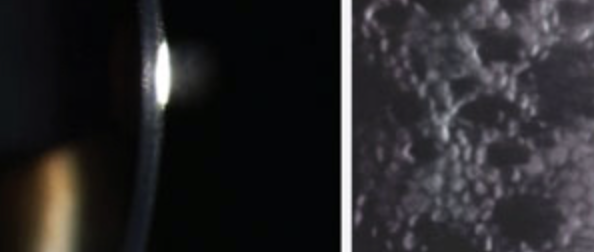 |
| Researchers recently reported a high prevalence of corneal guttata in a Hispanic cohort. Photo: Irene Frantzis, OD |
Are some patient populations vulnerable to corneal endothelial compromise more so than others? Researchers in Mexico recently assessed the central corneal specular microscopy of healthy Hispanic adults and found a high prevalence of corneal guttata, outgrowths of Descemet’s membrane produced by distressed endothelial cells, with a higher preponderance in female patients. They presented their results in Denver at the 2022 ARVO annual meeting.
The study included 702 eyes from 356 patients (55% female). The mean age was 70. The researchers considered endothelial pleomorphism if <50% of cells were hexagonal and polymegethism if the coefficient of variation was >40%.
The mean endothelial cell density was 2255.09 cells/mm2, mean cell area was 458.85µm2 and mean central corneal thickness was 522.37µm. Mean endothelial cell density and cell hexagonality in this Hispanic population was lower than in other reports. The study determined that 76% of the patients had a pleomorphic endothelium, with a significant difference in cell hexagonality between male and female patients. Also, 48% of patients had polymegethism, and 18% had corneal guttata, with 64% of the corneal guttata patients being female.
“More information is needed regarding endothelial morphometric characteristics in Hispanics,” the researchers wrote in their abstract. “Knowing the average endothelial parameters in our population can allow us to predict whether the endothelial pump function will tolerate surgery performed on the eye before affecting corneal transparency.”
Original abstract content © Association for Research in Vision and Ophthalmology 2022.
Quiroga-Garza M, Ortiz Morales, Bastán-Fabián D, et al. Prevalence of corneal endothelial pleomorphism, polymegethism and guttata in a Hispanic population. 2022 ARVO annual meeting. |

